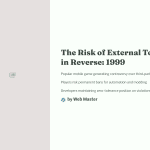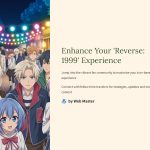 Reverse: 1999 is more than just a stylish, story-driven gacha RPG; it’s a playground for strategic minds and visual enthusiasts alike. The recent updates have expanded the customization system, allowing players to personalize characters, adjust battle UI, and even fine-tune performance settings. This guide dives deep into the best ways to utilize these features, ensuring you stand out both in combat and style. With increased emphasis on accessibility and performance optimization in 2025, mastering these customization options can significantly improve your gaming experience and give you a competitive edge in PvP and high-tier PvE modes.
Reverse: 1999 is more than just a stylish, story-driven gacha RPG; it’s a playground for strategic minds and visual enthusiasts alike. The recent updates have expanded the customization system, allowing players to personalize characters, adjust battle UI, and even fine-tune performance settings. This guide dives deep into the best ways to utilize these features, ensuring you stand out both in combat and style. With increased emphasis on accessibility and performance optimization in 2025, mastering these customization options can significantly improve your gaming experience and give you a competitive edge in PvP and high-tier PvE modes.

Character Skin Customization
Reverse: 1999 offers a robust skin system that allows players to change the visual appearance of their characters. Skins are not merely cosmetic; some even come with unique animations or voice lines. Players can unlock skins through events, purchases, or progression. To equip a skin, go to the character profile, tap “Appearance,” and choose from your unlocked designs. It’s crucial to understand that some skins can impact perception in battles, especially when opponents may misjudge your setup based on visual cues.
Moreover, newer skins added in 2025 include seasonal effects, dynamic lighting, and thematic particles. These not only look stunning but also indicate the evolution of character design in the game’s visual development.

UI Customization Settings
The UI customization introduced in late 2024 has empowered players to streamline their interface. From resizing HP bars and minimizing floating texts, to repositioning ability panels and adjusting font size, the freedom is extensive. Navigate to “Settings” → “Interface Layout” to begin modifying.
Players engaged in long sessions or competitive play have reported reduced fatigue and increased clarity by setting up a clean, distraction-free interface. For those playing on smaller screens or older devices, toggling minimal UI can also drastically improve FPS stability.

Performance and Graphic Optimization
Graphics settings are crucial for balancing visuals and performance. The 2025 optimization patch includes adaptive resolution scaling, auto-detection for low-end hardware, and new toggle options for VFX, bloom, and motion blur. Access these in the “Settings” → “Graphics.”
For players on mobile or emulators, disabling extra effects like depth-of-field and volumetric lighting can add up to 25% FPS improvement. A newly added “Battery Saver Mode” dynamically lowers unnecessary animations during idle scenes.

Voice and Language Customization
To improve immersion, Reverse: 1999 supports multi-language audio packs, allowing players to select English, Japanese, or Korean voices independently of subtitle language. This is excellent for players who prefer specific voice acting styles.
Navigate to “Audio Settings” to download language packs. Each voice option comes with character-specific flavor that can change the tone of dialogue delivery. For narrative fans, this opens new emotional interpretations of key story arcs.

Accessibility Options for Enhanced Comfort
Inclusion continues to be a core focus for Reverse: 1999. The game now includes colorblind modes (three types), simplified combat animations for photosensitive players, and screen reader support for key UI elements. These can be found under “Accessibility” in settings.
Enabling vibration feedback, camera shake reduction, and subtitle scaling ensures players of all needs can enjoy a tailored experience. Developers have actively engaged with the community for feedback, leading to a noticeable increase in player retention and satisfaction.

Save Profiles and Loadouts
One of the most game-changing additions in the latest patch is the ability to save and swap multiple profiles. You can now create different setups for PvE, PvP, and event modes—including UI layouts, graphic settings, and even control preferences.
To access this, go to “System Settings” → “Manage Profiles.” This is a time-saver for players who participate in various game modes and want optimal settings without constant tweaking. Power users can even assign quick-swap gestures or hotkeys (on PC).
*Cap turing unauthorized images is prohibited*
turing unauthorized images is prohibited*






